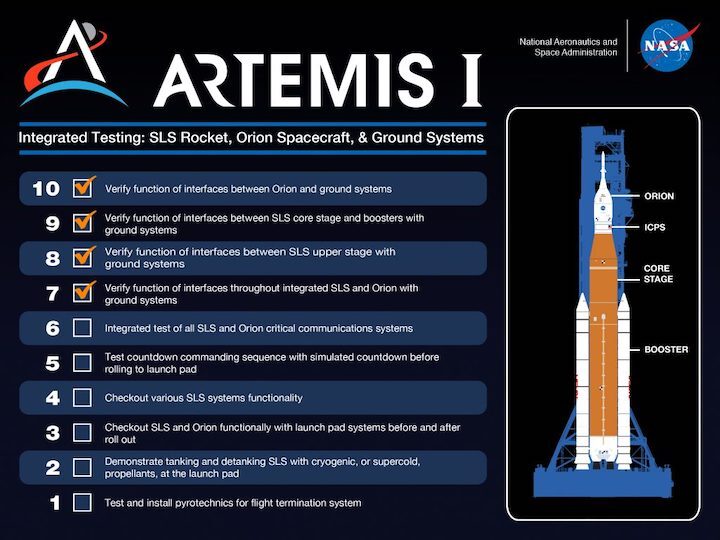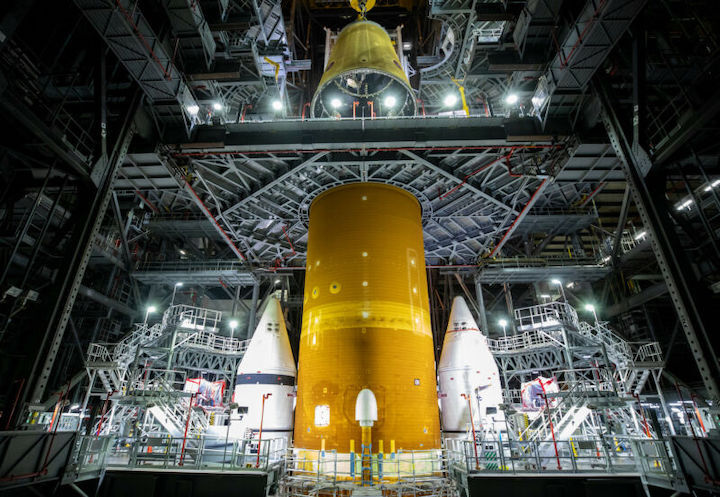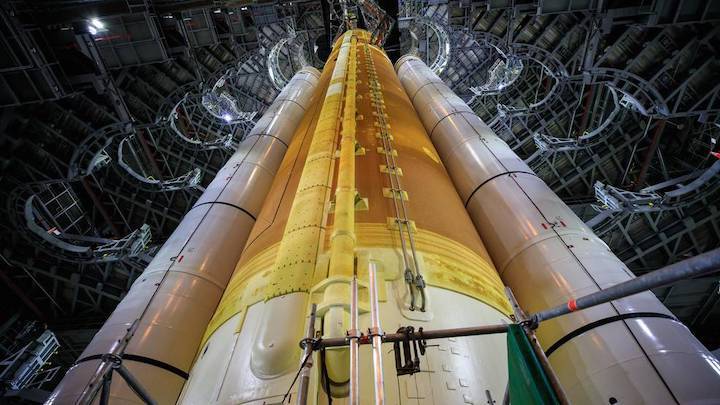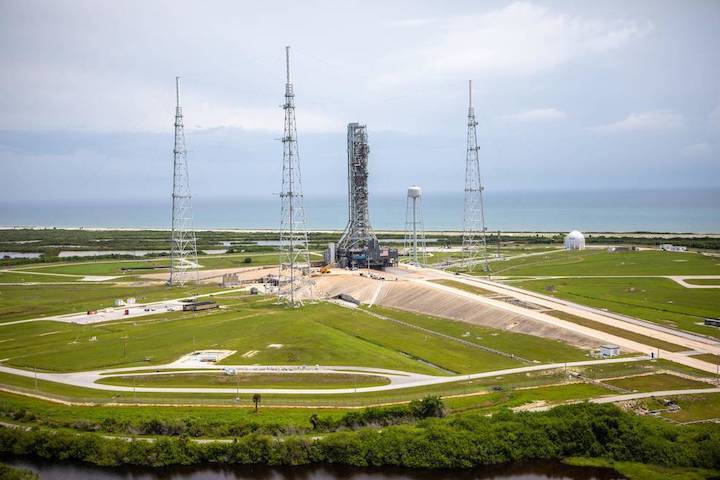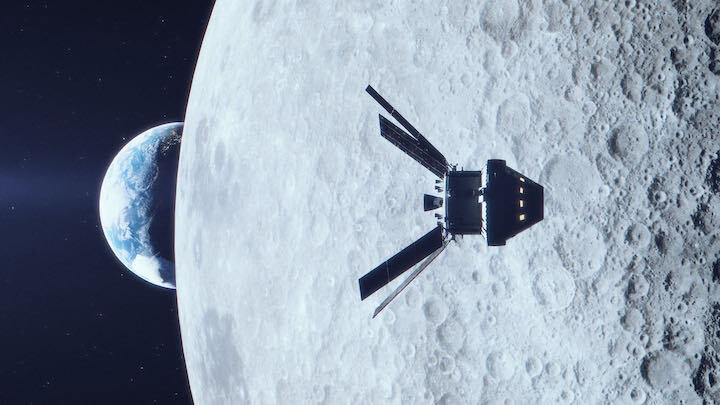8.12.2021
Artemis 1 launch attempt constraints, rocket readiness slips to mid-February 2022
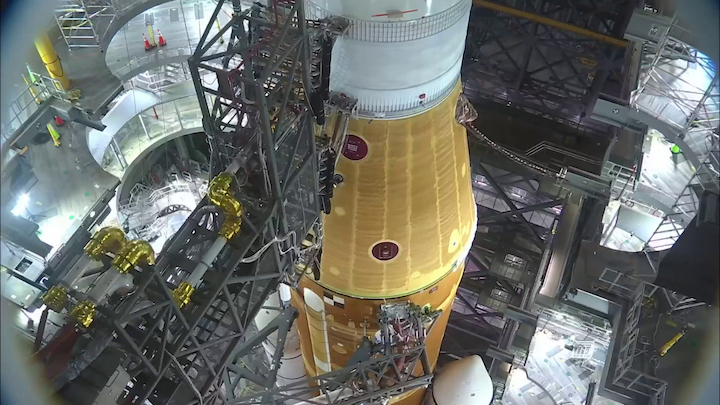
When NASA’s Exploration Ground Systems (EGS) program and prime processing contractor Jacobs have configured the Artemis 1 Space Launch System (SLS) vehicle for launch day, they expect to have one-week periods to get the mission to the Moon off the ground. Between propellant consumption of the two liquid SLS stages and a 20-day long period where the range safety system is validated for use, up to three attempts could be conducted to tank the vehicle and launch within that week’s time before teams would have to stand down.
EGS, Jacobs, and the Orion and SLS teams are continuing testing and checkout of the vehicle, but the latest projections for the first rollout to Launch Pad 39B have moved from late-December 2021 to mid-January 2022. Meanwhile, engineers are also troubleshooting a problem with a controller for one of the four RS-25 engines in the SLS Core Stage. The nature of the problem and the path to a resolution are still unknown and will need to be factored in, but current forecasts for when the vehicle will be ready to launch have moved from the end of January to mid-February.
20-day clock on range safety flight termination system validation starts in the VAB
Artemis 1 is the first launch for both the Exploration Ground Systems and Space Launch System programs within NASA’s Exploration Systems Development (ESD) human spaceflight division. For this first launch, SLS will propel an uncrewed Orion spacecraft to the Moon; together, the celestial mechanics and performance requirements for this specific mission define launch periods that repeat with opportunities to launch for about two weeks followed by about two weeks without opportunities.
While those requirements determine an overall window of opportunity for SLS to send Orion to the Moon, the launch processing teams at KSC are also working with their own operational requirements. EGS and Jacobs will be working to line up their operational clocks with the lunar launch periods.
For Artemis 1, they are working within operational constraints to have the vehicle and ground infrastructure ready to make launch attempts during a seven-day stretch within the overall 10-15 day lunar launch periods of opportunity. After the celestial mechanics constraints, there is an operational constraint on the length of time the range safety flight termination system (FTS) on the vehicle is valid for use.
“There’s an end-to-end [functional] test that the [Eastern Test Range] requires you have in essentially a flight configuration,” Jeff Spaulding, Senior NASA Test Director (NTD) who will serve as the Lead NTD for the Artemis 1 launch, said in a November 29 interview with NASASpaceflight. “When I say ‘flight configuration,’ I mean flight batteries installed and all of your systems up and processing — flight codes, the whole bit, right?”

Credit: NASA/Radislav Sinyak.
(Photo Caption: Wider views of the Artemis 1 stack surrounded by platforms and scaffolding in VAB High Bay 3 shortly after Orion was lifted on top of SLS in late October. The platforms provide 360-degree access around the circumference of the vehicle at 10 different levels, which help enable almost the entire pre-launch campaign to be conducted inside the VAB. The access necessary to perform the FTS end-to-end test is only in the VAB.)
“The requirement says that once you do the flight termination system end-to-end test, that final flight configuration test with flight batteries, etcetera, you need to have launched within 20 days or you need to re-perform that test. That gives [range safety] confidence that your system is still functioning nominally [and] there’s been no changes [to the configuration]. So that’s a requirement that we have to meet to fly off the range.”
“That 20-day requirement is the tailored requirement that we worked with the range because this was a new vehicle and we knew that it was going to take us a little bit more than what they nominally expected — but certainly not outside the realm of where we are,” Spaulding added.
The flight termination system operates independently from the rocket since it needs to be able to function whether or not the rocket is functioning. Part of configuring the FTS for flight and preparing for the test is installing the batteries; the batteries have their own limit, though it is longer. “There’s a battery life constraint on when we activate the batteries — that’s 90 days [of] ‘wet life’ from the time they’re activated until they need to be changed out again,” Spaulding also noted.
The 20 days that the FTS is validated for launch attempts is the more constraining of the two clocks. The end-to-end test that validates the FTS and starts the 20-day clock has to be performed in the Vehicle Assembly Building (VAB) because it requires access inside the SLS vehicle; EGS and Jacobs then need to complete the remaining pre-launch preparations in the VAB and at the launch pad.
Within the approximately three-week period (20 days) where the FTS is valid for launch use, the final VAB preps for launch take about a week, and preps at the pad for launch (including the countdown) take about another week, which will leave about a week left to carry out tankings and launch attempts. “Once you do that [FTS end-to-end] test, from that point until [we are] ready for launch right now is about 13 days,” Spaulding explained.
“The time to finish [work] in the VAB, roll to the pad, and then do the preps at the pad to get ready to launch is 13 days. So we have about seven days of launch attempts to get off of the ground after that point. That’s the global picture of what that 20-day requirement is and what the constraint is.”

(Credit: Stephen Marr for NSF)
(Photo Caption: The partial NASA worm logo is seen on the outside of right-hand Solid Rocket Booster for Artemis 1. The missing portions of the letters are the yet-to-be-completed cable trays on the boosters that carry critical wiring for — among other things — the SLS’s flight termination system. The cable trays will be fully closed out and covered for flight.)
Final assembly of the Artemis 1 vehicle was completed in late October, and EGS and Jacobs are conducting several weeks of integrated vehicle checkouts in parallel with the beginning of final servicing and pre-launch vehicle closeouts. During tests in November, one of the redundant computers in the RS-25 engine controller for engine 4 would no longer power up correctly.
The control units are the major component that was upgraded between use of the engines on the final Space Shuttle missions and adaptation of the existing Space Shuttle Main Engine (SSME) Block II design for use on SLS . The new RS-25 engine controller units for SLS still employ two redundant digital computer units (DCUs) that operate on independent control channels, A and B.
RS-25 prime contractor Aerojet Rocketdyne and the SLS Program have been troubleshooting the controller problem with EGS and Jacobs since prior to the Thanksgiving holiday. A problem resolution team continues to evaluate test data and consider forward options, but so far no conclusions or decisions have been reported and it is uncertain what the impact will be to the schedule.
The controller unit is a replaceable item, and remove and replace operations for controllers were carried out on engines installed in Shuttle orbiters while stacked in their vertical, launch orientation during that program; however, it is uncertain whether a controller replacement is possible “in-place” on an SLS Core Stage.
Impacts to the schedule remain uncertain from the additional time required to resolve the engine controller problem. Ground support equipment for vertical engine installations was also reportedly moved into the VAB last week, but NASA indicated on December 2 that an engine replacement was not an option on the table at that time.
Although troubleshooting impacts are uncertain, schedule projections are currently forecasting that rollout of the vehicle from the VAB to Launch Pad 39B would be no sooner than mid-January 2022 with final launch readiness now no sooner than mid-February. Earlier forecasts had placed launch readiness at the very end of January, just outside the end of a launch period where SLS could place Orion on a trans-lunar trajectory.

Credit: NASA.
(Photo Caption: A simplified render of the Artemis 1 vehicle and Mobile Launcher standing on Launch Pad 39B. NASA converted the former Saturn and Shuttle pad back to a “clean pad,” with no major vehicle service structures. Saturn had a mobile service structure and Shuttle had fixed service structures. But the concept of launch operations for SLS is to roll from the VAB to the pad in a ready-to-launch configuration. If a system like the flight termination system requires servicing, it is more likely to require a return to the VAB.)
Launch readiness is an estimate of when all pre-launch preparations can be completed and is less certain for this first launch campaign than calculations of vehicle performance or the position of the Moon. When the pre-launch work reaches points such as the time-critical FTS end-to-end test, then the schedule will have to be aligned with a lunar launch period; however, with several weeks of testing and closeouts still remaining, projections of a time-frame for launch readiness will move between and through the recurring launch periods.
The current mid-February forecast for launch readiness would more or less line up with the opening of Launch Period 18 on February 12; the Exploration division programs had already tentatively targeted the February launch period to line up their final readiness review calendar.
The launch periods are generally available for durations of between 10 to 15 days, so there’s less margin than before to make the February launch period, which closes on February 27. The next opportunity, Launch Period 19, opens on March 12.
SLS stages’ liquid hydrogen requirements close to limits of available launch pad capacity
Within the seven-day period of launch opportunities expected within the remainder of the FTS clock, the currently available storage of liquid hydrogen (LH2) and liquid oxygen (LOX) propellant at Launch Pad 39B for the two SLS stages limits the number of tankings that can be made.
“For Artemis 1, we have the old hydrogen and oxygen spheres out at 39B, and we know that we can have three attemps over a seven day period, strictly based on commodities,” Mike Sarafin, NASA’s Artemis 1 Mission Manager, said in a September interview with NASASpaceflight.
The SLS Core Stage strained the cryogenic storage capacity at the Stennis Space Center for its Green Run test campaign, and combined with the in-space Interim Cryogenic Propulsion Stage (ICPS), the vehicle also comes close to the limit of the existing LH2 storage sphere.
In a November 2018 tour of Launch Pad 39B, NASA Pad Operations Manager Ken Ford said that the two LH2-LOX stages in the SLS Block 1 vehicle could use up to 730,000 gallons of liquid hydrogen on the day of a launch attempt. Ford said that the current hydrogen sphere can hold up to 850,000 gallons of LH2, of which 765,000 gallons is available to support a launch. That’s enough for a single launch attempt but not enough to support another the next day.
The usage includes not just the time it takes to load propellants into the tanks of the two stages, but the time required to thermally condition the loaded propellant and propulsion system equipment for ignition and then up to another two hours of launch window hold time after that. While the vehicle is filled with liquid propellant, some of the LH2 is consumed for engine conditioning, and some boils off and needs to be replenished. If a launch attempt were to be scrubbed after waiting through an entire two-hour launch window, and the propellant in the tanks was drained back into the spheres, they would end up being about 280,000 gallons short of the LH2 needed for another attempt.
That deficit would be smaller for attempts that are scrubbed before using up the full two-hour hold time, but in case of a scrub on the first Artemis 1 attempt, a 48-hour turnaround would be required.
“That assumes that you tanked, that you scrubbed in your window while you were fully tanked, and then had to detank, and then we would actually have to do a little bit of hydrogen top off using tankers to achieve the next attempt 48 hours later. And then, assuming that we tanked on that one and then scrubbed after we were fully tanked, we would have a third attempt after 72 hours because we would have to replenish both hydrogen and oxygen out at the pad. So we could get three attempts in seven days with [that] replenishment plan.”
“Because this vehicle is so big and we use so much liquid hydrogen and liquid oxygen [in both the Core Stage and ICPS], it takes a while to reconfigure and set up for the next attempt,” Sarafin added. “So we’re preserving the option for a next attempt after a certain amount of time by creating a maximum of a hundred and twenty-minute window.”
In between launch attempts for Artemis 1, tanker trucks will bring in more supplies of liquid hydrogen to augment the remaining commodities in the sphere. NASA already uses tanker trucks to replenish cryogenic boiloff in the spheres at the pad, bringing them in from their vendor; in order to expedite replenishing the LH2 sphere, the agency has contracted with ULA to take LH2 stored in the hydrogen storage sphere at Launch Pad 37B that currently supports Delta IV launch operations.
EGS has constructed a second, larger liquid hydrogen storage sphere at Launch Pad 39B to augment the existing LH2 sphere. “[That] is actually why we’re building the larger hydrogen sphere out at Launch Complex 39B — to relieve ourself of the hydrogen constraint that we have on Artemis 1,” Sarafin said.
Assembly of the storage sphere is largely complete, but it is not yet fully activated and it will not be ready to support SLS launch attempts until Artemis 2. Once available, the second tank will allow back-to-back launch attempts for both the SLS Block 1 and Block 1B vehicles and will allow additional launch attempts to be made within the same space of one week.
“We’ll do better for Artemis 2 because we have that [second] big [LH2] sphere that we’re trying to get finalized, but for now we’re still kind of stuck to the three attempts in seven days,” Spaulding said. “We certainly want to maximize our capabilities [as we progress].”
If EGS and Jacobs can complete the remaining pre-launch preparations in the VAB and at the launch pad and complete final pre-tanking countdown preparations within the 13 days currently forecast, the three vehicle tankings would fit within the rest of the overall 20-day length of time that the FTS is valid for launch use. “It fits in there kind of nicely in as much as if you take the 13 days to get to a [first launch attempt] and then you have the 7 days of launch attempts,” Spaulding said.
“[That] would get us three attempts that kind of fit exactly in that 20-day constraint. We hope that someday we’ll be able to [finish preparations] a little faster in the VAB, but it’s just the nature of having to close out those areas after you’re done that kind of drives you to where you are in getting the vehicle ready to roll out and all that.”
Although the range safety requirements and cryogenic commodity constraints would narrow down the number launch attempts available, Sarafin said that if there are no big issues with the flight hardware or the ground infrastructure, three launch attempts should provide a good opportunity to finally get the first SLS launch underway.

Credits: NASA and NASA/Glenn Benson
(Photo Caption: A slide from a NASA presentation on the new LH2 storage sphere being assembled at Pad 39B shows its relative location in the pad area. Inset in the upper right is an image taken in October 2021 of the state of construction for the new sphere. NASA plans to have the second sphere activated and online in time to support the Artemis 2 launch; the added capacity will allow launch attempts for both the SLS Block 1 and Block 1B vehicles to be conducted on back-to-back days, if necessary.)
“In general, two or three attempts has shown that we can get off [the pad] for most launch vehicles, assuming that [there is no] significant technical issue,” Sarafin said. “So we have a high level of confidence that we will be able to get off [by a third launch attempt], assuming we don’t run into a significant technical issue.”
After 20 days, requirement is to reperform the end-to-end test
If Artemis 1 hasn’t launched by the time the 20-day clock runs out, the FTS can be revalidated for another set of launch attempts by running the end-to-end test again. If the vehicle is on the pad, a rollback will be necessary, which will require breakdown of the launch countdown configuration for a return to the VAB.
As the name implies, the end-to-end test verifies that arming and destruct commands sent from range safety are correctly received and processed by the devices on the vehicle. Internal access to the SLS boosters and Core Stage is needed so that simulators can be positioned during the test to prevent an actual destruction of the vehicle.
“We do that test in the VAB because it requires access inside a couple of the compartments,” Spaulding explained. “[One area is] inside the forward skirts of the boosters, and also in the intertank area of the Core Stage; that’s where the boxes are. We have to install simulators and things like that [for the test].”
“Because we’re going to essentially demonstrate that the system works, we need to have it separated from the ordnance so we don’t send any commands to that,” he added. “So we have the simulators installed, we’ll also have to install our communication codes and things like that so we’re in a flight config. And we’ll have the range guys with us as well.”
Once the test is complete, then the 20-day clock would start again, the simulators and test equipment would be removed, the internal compartments closed out for launch, and the 13-day pre-launch sequence would need to be repeated.

Credits: NASA/Frank Michaux and Kim Shiflett.
(Photo Caption: VAB platforms, scaffolding, and test equipment are shown deployed around the forward skirts of the SLS Boosters and Core Stage intertank in the main image taken in August 2021. Inset in the lower left, an image taken from the Mobile Launcher umbilical tower during the umbilical release and retract test in late September shows the location of yellow and red-colored access doors for the Boosters and Core Stage on the -Z side of the vehicle. Without the VAB platforms, those areas cannot be safely reached for vehicle servicing and conducting tests.)
Access inside the booster forward skirts and Core Stage intertank is only available from platforms that can be extended around the vehicle in the VAB. After the Space Shuttle program, KSC ground processing returned to a “clean pad” concept of launch operations at Pad 39B, first for the since-canceled Constellation Program vehicles and then for SLS.
“We had made decisions long ago to go with a clean pad concept, and [one of the results of] that [was] we were not going to be able to access some of these areas [out at the pad],” Spaulding said. “In the previous program, you may have recalled that we had a service structure that rotated up and gave us the ability to get to those areas as well as into the body of the Space Shuttle.”
During Shuttle, vehicles were assembled in the VAB on a mobile launch platform that was moved out to the pad for the final weeks of pre-launch checkouts. The umbilical tower was part of a permanent, fixed service structure (FSS) on the Launch Complex 39 pads. A rotating service structure (RSS) connected to the FSS, and provided access to the side-mounted Shuttle orbiter for payload integration as well as access to internal compartments of the Shuttle vehicle’s liquid propellant External Tank and Solid Rocket Boosters (SRBs).
Following handover of Pad 39B from the Shuttle program to the Constellation program in mid-2009, those large Shuttle service structures were eventually demolished and removed in 2011. Spaulding noted that keeping the pad area relatively clear of vehicle umbilical towers and service structures would reduce overall maintenance costs.
“We don’t have any of that [now] because it’s not a [side-mount] vehicle [and] it’s really cost-prohibitive almost to have a lot of stuff at the launch pad sitting there not in use having to maintain [it],” he said. “So the clean pad concept was really a good one from our perspective to not have to perform maintenance all the time and just roll out the tower when we’re ready to go with the vehicle.”
But Spaulding said it does mean less servicing can be done at the pad. “It doesn’t give you access to all of those areas [at the pad],” he said. “That access in the VAB comes from moveable platforms that are part of the VAB itself, and it does not exist at the pad.”

The SLS Mobile Launch, a hold-over from Constellation, on a modified Apollo-era crawlerway transporter arrives at LC-39B for testing. (Credit: Stephen Marr for NSF/L2)
For SLS, vehicle integration, testing, and checkouts are completed in the VAB; after rollout to the pad by a crawler transporter, the Mobile Launcher is set down onto pedestals and connected to the pad electrical, fluid, and environmental control services.
Decision point for starting the clock in the VAB
NASA will ultimately have to make a decision of when to proceed with the installation of the FTS batteries and when to run the FTS end-to-end test. Since the 20-day clock would be critical to the schedule, the timing of the test relative to other final launch preparations could be different during this first-time experience when compared to a more standardized processing flow in the future.
The vehicle and Mobile Launcher will be back in the VAB following a full run-through of the launch countdown timeline called the Wet Dress Rehearsal (WDR). Once the vehicle arrives at the pad on the Mobile Launcher for the WDR, ground crews will first go through the pre-countdown preparations at the pad. Pad connections to the Mobile Launcher and SRB hydrazine servicing will be conducted on the flight vehicle in a nearly ready-to-launch configuration.
Once back in the VAB, final configuration of the FTS for launch is the primary task, which includes battery installation, ordnance installation, and the time-critical end-to-end test suite. “That’s the bulk of what we do when we come back with those tests,” Spaulding said.
“We do a couple of things. [We have to install] the batteries, we have to install the simulators onto the equipment, onto the firing lines, and some of the other areas because we need it isolated from the system. We do have some ordnance that we’re going to install, too; we’ll do that before we get into the end-to-end test.”
“We do the end-to-end test on the Core Stage and then a test on the boosters [as] part of the end-to-end test on those flight termination systems,” he added.

Credit: NASA.
(Photo Caption: An excerpt from a February 2021, Artemis 1 mission availability document revision produced by the Mission Analysis & Integrated Assessments (MAIA) group within NASA’s Exploration division. The excerpt was shared on the NSF forums by a poster who obtained it through a Freedom of Information Act (FOIA) request. Launch attempts for Artemis 1 not only have to be synchronized with lunar launch opportunities but also with ground infrastructure and Eastern Test Range safety requirements.)
ESD and the EGS, Orion, and SLS programs within the division will also be working to be ready to conduct the final pre-flight reviews when the hardware is ready to fly, and one of big decision points will be proceeding into the FTS end-to-test.
“There are decisions that definitely have to be made, both to do the wet battery activation — because we need those flight [FTS] batteries installed — and then to proceed down that path to get to the end-to-end test and get ready to roll out [for launch],” Spaulding said. “There will be other reviews after that decision, final ones, to make sure that we’re able to roll out, and there’s a number of different milestones and milestone reviews along the way.”
“Definitely there is a management decision that says ‘we understand where we are from a constraint perspective and the ability to get off the ground before we do [the test] because that starts those two timers,’ I’ll call them. So those are big milestones that fall into some of our other reviews as well to give us a go to press on to do that.”
Other work in the VAB after the vehicle and Mobile Launcher return from the WDR includes preflight stowage of mission equipment inside Orion and removal of some ground test instrumentation. Any additional work or maintenance necessary after the WDR on the flight hardware, Mobile Launcher, or equipment at the pad would factor into when the FTS end-to-end test takes place.
In part due to the time constraints imposed by the 20-day clock, the launch processing teams will begin working seven days a week when the FTS end-to-end test is performed. Teams are already divided into multiple work shifts and working six days a week, but beginning with the FTS test they will be working around the clock to complete launch preparations, 24/7.
Leaky valve issue forces Boeing to swap out Starliner’s service module
"Ongoing investigation efforts continue to validate the most probable cause."
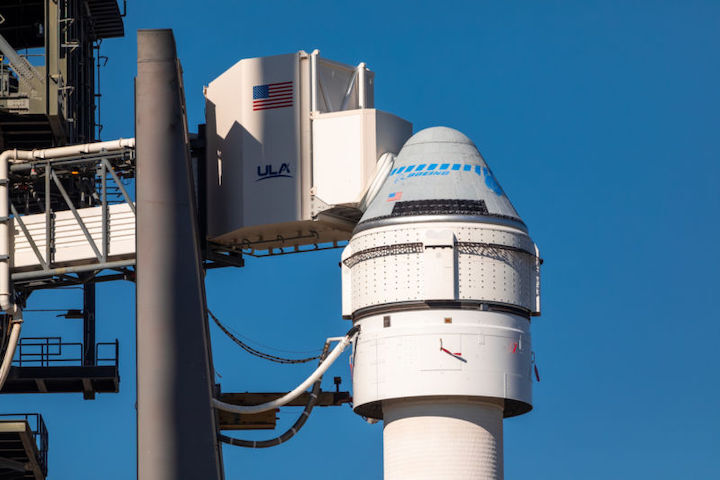
In early December 2019, the Starliner spacecraft is mated to its Atlas V rocket.
Nearly two years have now come and gone since Boeing's Starliner spacecraft made its unsuccessful debut test flight, launching on December 20, 2019. Now, finally, there is some clarity on when the vehicle may launch again and attempt to dock with the International Space Station.
NASA and Boeing said Monday that they were working toward a launch of Starliner in May 2022. To accommodate this launch date for the "Orbital Flight-2" or OFT mission, Boeing will swap out a faulty service module—which provides power and propulsion to the Starliner capsule in flight—with a new one.
Boeing initially tried to fly OFT-2 in August. However, with less than five hours remaining in the countdown to launch, during a routine procedure, 13 of the 24 valves that control the flow of dinitrogen tetroxide oxidizer through the service module of the spacecraft would not cycle between closed and open. The launch was aborted.

